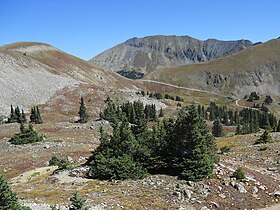| Tomichi Pass | |
|---|---|
 Tomichi Pass Tomichi Pass | |
| Elevation | 11,962 ft (3,646 m) |
| Traversed by | Forest Road 888 |
| Location | Gunnison County, Colorado, U.S. |
| Range | Sawatch Range |
| Coordinates | 38°36′13″N 106°23′00″W / 38.6036070°N 106.3833589°W / 38.6036070; -106.3833589 (Tomichi Pass) |
| Topo map | Whitepine |
Tomichi Pass (elevation 11,962 feet (3,646 m)) is a high mountain pass in the Sawatch Range of the Rocky Mountains of Colorado. It is located in Gunnison County and in the Gunnison National Forest. The pass divides the watersheds of Middle Quartz Creek to the north and Tomichi Creek to the south.
The pass is traversed by Forest Road 888, which is a four-wheel-drive path and is particularly narrow and exposed on the north side.
The pass was originally traversed by a pack trail connecting the mines and mining camps to the north with those to the south in the 1870s. Improvements eventually allowed the passage of wagons, but the road never saw significant traffic.
Geology
Tomichi Pass lies on a ridge composed of Middle Tertiary intrusive rock. This stock of granitic rock was intruded into older Proterozoic granitic rock and Paleozoic sedimentary rock in the area. Also intruded were many igneous dikes and sills. In the 1800s, miners sought profitable veins of gold, silver, and lead along these intrusions. On either side of the pass is evidence of past mining activity. On the ridge to the east of the pass, seemingly out of place, are ash flow tuffs. These rocks originated from volcanic activity in the San Juan volcanic field to the southwest. Eruptions were occurring in the Middle Tertiary (23 to 34 million years ago), approximately the same period granites were being intruded below the surface.
Erosion has since removed most of the tuff and has exposed the intrusive rock that forms the pass today. Contributing to this erosion were Pleistocene glaciers. They sculpted the valleys on both sides of the pass and deposited moraines down valley.
References
- ^ "Tomichi Pass". Geographic Names Information System. United States Geological Survey, United States Department of the Interior.
- ^ Helmuth, Ed; Helmuth, Gloria (1994). The Passes of Colorado: An Encyclopedia of Watershed Divides. Boulder, Colorado: Pruett Publishing Company. ISBN 0-87108-841-X.
- "Tomichi Pass Trail". trails.colorado.gov. Retrieved 29 December 2020.
- Vandenbusche, Duane (1980). The Gunnison Country. Gunnison, Colorado: B&B Printers. pp. 394–395. LCCN 80-070455.
- ^ Streufert, R. K.; Morgan, M. L.; Eakins, Wynn; Hemborg, H. T. (1999). Geology and mineral resources of of [sic] Gunnison County, Colorado. Resource Series RS-37. Denver, Colorado: Colorado Geological Survey.
- ^ Prather, Thomas (1999). Geology of the Gunnison Country (2nd ed.). Gunnison, Colorado: B&B Printers. LCCN 82-177244.
External links
- Tomichi Pass, 4x4explore.com
- Tomichi Pass ATV Trail, atvtrails.org